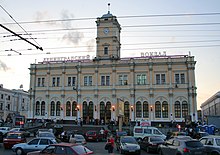Oktyabrskaya zheleznaja doroga
The Oktjabrskaja schelesnaja doroga , literally "October Railway" ( Russian Октябрьская железная дорога ), is an independent branch of the Russian State Railways (RŽD) with a 10,000 km long route network in the northwest of the European part of Russia .
The October Railway, which was given its current name in 1923 in memory of the October Revolution of 1917, operates the oldest railway connections on Russian territory with the section from Saint Petersburg to Pavlovsk and the Moscow – Saint Petersburg high-speed line . The catchment area of the branch's route network extends from Moscow to the Murmansk Oblast beyond the Arctic Circle .
history

The history of the October Railway and the entire railway traffic in Russia began on November 11, 1837 with the 27 km long railway line between the then Russian capital Saint Petersburg and the suburb of Tsarskoe Selo, which was completed after a year of construction . The line, built with the participation of the Austrian engineer Franz Anton von Gerstner , which had a more symbolic meaning due to its shortness, was the first public railway in Russia, but unlike other European lines, it was built with a gauge of 1829 mm (6 feet).
Four years after the construction of the line, Tsar Nicholas I approved a new project that envisaged a more than 600 kilometers long, double-track and practically straight rail link from Petersburg to Moscow , the second largest city in the empire. This time, the 1524 mm (5 foot) gauge was used, which later became the standard for all railway lines in the Russian Empire . The line was put into regular operation at the end of 1851 and was named Nikolaus-Bahn in 1855 in honor of the recently deceased Tsar . In 1857 the main company of Russian Railways ( Главное общество Российских железных дорог ) was founded as a joint stock company for the purpose of managing the route and building further railway lines in Russia . In the second half of the century, several other, originally mostly private, railway companies were founded, under whose direction other lines that are now part of the October Railway were created. Examples include the Warsaw-Petersburg Railway , the Baltic Railway , the Sestrorezker Railway , the Finnish Railways Directorate (the latter built the line between Petersburg and Chijtola in what was then the Grand Duchy of Finland ) and the Moscow- Windau - Rybinsk Railway .
By 1894, the Russian state bought the private railway companies of the Nikolausbahn, the Warsaw-Petersburg and the Baltic Railway and subordinated them to the Russian Ministry of Transport. On January 1, 1907, large parts of the north-west Russian route network went to the newly established state-run Northwestern Railway . At that time, the total length of the route network of this new company was already a good 2700 kilometers. One of the largest construction projects of the Northwest Railway realized before the October Revolution was the Murman Railway , which connected the capital with the strategically important ice-free northern sea port in Murmansk . From 1918 to 1920, Leon Trotsky's private train traveled between the Red Army front lines.
In 1923 the line between Petrograd and Moscow, previously known as the Nikolausbahn, was renamed the October Railway, and in 1929 the line and the entire network of the former Northwest Railway were subordinated to the Soviet State Railways . Thus, the Oktjabrskaja schelesnaja doroga became a branch of the Soviet railways. By the middle of the 20th century, practically the entire railway network in the northwest of the Russian SFSR was assigned to the October Railway, so that its route length in 1959 was already around 8,000 km.
Also in the 1950s, the electrification of the entire route of the former Nikolausbahn including branch lines was completed. In 1984 the Oktjabrskaja schelesnaja doroga took the first (and only) high-speed train of the Soviet Union into regular service with the ER200 . In the late 1990s and 2000s, were taken, among others, as part of the preparations for the celebrations of the 300th anniversary of St. Petersburg, the October Railway further modernization and expansion projects in attack, including Petersburg, the new was Ladoga station built .
business

The current network of Oktyabrskaya zhelesnaja doroga is a total of 10,372.7 kilometers long, making the railway one of the largest branches of the Russian state railways. Within Russia, the network has points of connection with the networks of the Northern and Moscow Railways, and across borders to the rail networks of Finland , Estonia , Latvia and Belarus .
Among the regions of Russia , whose orbits are operated by the October Railway, include the following: Murmansk Oblast , Republic of Karelia , Leningrad Oblast , Saint-Petersburg , Vologda Oblast (partial), Pskov oblast , Novgorod Oblast , Tver Oblast , Yaroslavl Oblast ( partially), Moscow Oblast (partially) and Moscow City (partially).
The most important routes include:
- Saint Petersburg – Moscow ( high-speed line , total length 650 km),
- Saint Petersburg – Murmansk ("Murman Railway", 1448 km),
- Saint Petersburg– Veliky Novgorod ,
- Sonkowo - Pechory-Pskowskije (Latvian border) (part of the Rybinsk-Pskow-Riga Railway ),
- Saint Petersburg - Vyborg - Buslowskaya (Finnish border).
The administrative headquarters of the Oktoberbahn is in Saint Petersburg, there are also six regional directorates in Moscow , Saint Petersburg , Saint Petersburg- Vitebsk , Volkhovstroi , Petrozavodsk and Murmansk . In 2008, 24.533 million long-distance passengers and 109.812 million local traffic and 130.244 million tons of goods were carried.
Web links
- Official website (Russian)
- Route diagram with stations to download (transcribed notation)
Individual evidence
- ↑ Data here and further on from the official RŽD website ( page no longer available , search in web archives ) Info: The link was automatically marked as defective. Please check the link according to the instructions and then remove this notice.